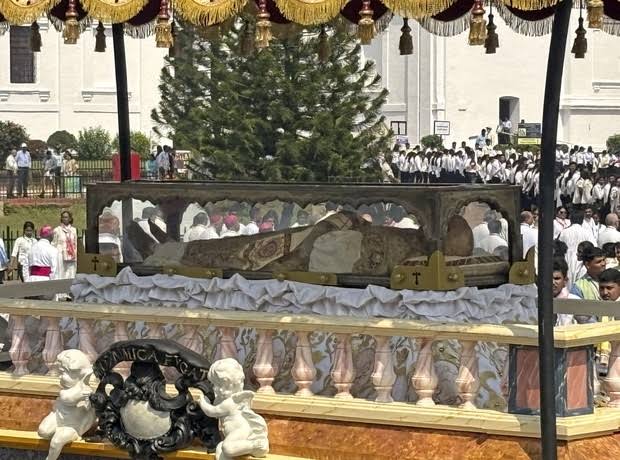Millions flock to Goa for exposition of St. Xavier’s relics

A casket carrying the remains of the 16th century Spanish missionary St. Francis Xavier is seen on its way to Se Cathedral in Old Goa, India, on Nov. 21, 2024, after leaving the nearby Basilica of Bom Jesus earlier in the day.
The remains are put on public display at the cathedral every 10 years. An exposition of the sacred relics of St. Francis Xavier, the famed 16th-century Jesuit missionary, has been held in the Indian city of Old Goa, in a once-in-a-decade event attracting millions of Catholics and tourists from across India and other countries.
The remains of Xavier, who was born in 1506 in what is now Spain and died in 1552 in China, lie in the capital of Indian State of Goa( forcibly held by Portugal as Colony from 1510 till recapture by India in 1961 ) from where he departed for his missionary work in the Malay Archipelago and Japan.
Christians account for only 2.3 percent of India’s population, the last official census in 2011 showed. There are many old Christian communities in the southern state of Goa. Xavier has been respected as the patron saint of Old Goa, which was once called “Rome of the Orient,” also by non-Catholic locals.
The saint’s relics are usually kept at the Basilica of Bom Jesus, one of the churches in the city designated as a UNESCO World Heritage. The remains in a glass container encased in a silver casket were moved by a vehicle to the Se Cathedral, located 500 meters away, on Nov. 21 for the exposition through Jan. 5.
Sekar Manivel, a Catholic and founder of an electronic vehicle manufacturer in the city of Chennai, said, “I feel blessed to drive my custom-made, special-purpose battery vehicle costing around 1 million rupees ($11,800) on which St. Xavier’s relics were carried during the procession.
“The decennial exposition is one of the most revered events in the state, drawing millions of devotees and tourists from India and abroad, according to Rohan Khaunte, tourism minister of the state government.
Among thousands of Catholics gathered to witness the ceremony to move the remains was Suzan Nirmal from Chennai.”I am feeling blessed to see and venerate the sacred body of St. Francis Xavier for the first time together with my family,” said Nirmal who came to the event with her husband and son.
Angelo Lobo, an Indian IT engineer who works in Oman, said he came to the previous expositions in 2014 and 2004 as well.”The body of St. Francis Xavier appears to have remained remarkably well-preserved” over the past decades, said the 52-year-old, referring to the relics that have retained much of their original appearance and are believed to have undergone very gradual changes for over 470 years.
Viewers can see Xavier’s body in a clerical garment, lying with his left hand on the abdomen and his bare feet seen from the garment’s hemline. His face is discernible, though with the skin peeled off at certain parts.
“St. Francis Xavier’s body is miraculously preserved by the grace of God. It was not mummified by any preservatives,” said Barry Cardozo, director of the Diocesan Centre for Social Communication Media, located in Panaji, the state capital.
The exposition of the relics of Xavier, co-founder of the Society of Jesus, was attended by the delegation from the Vatican on Nov. 26. Archbishop Edgar Pena Parra hailed the joint efforts of the Goa government and the Catholic Church in managing the large influx of pilgrims, local newspaper The Goan reported.
Xavier died on Dec. 3, 1552, on Shangchuan Island in southern China after spreading Christianity for more than two years in Japan. He was canonized by Pope Gregory XV in 1622.
In 1927, Pope Pius XI proclaimed him the “Patron of Catholic Missions.”Over 100,000 people came to the exposition on its opening day, according to Cardozo.”The exposition is a tradition done through four centuries” to pay respect to Xavier, the Catholic priest said. “The saint holds influence over people across all religions and ages” in Goa.
The event is expected to attract some 8 million visitors by the end of Jan. 5 when it will culminate with a closing Holy Eucharist, a Christian ritual.




